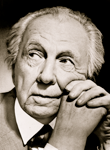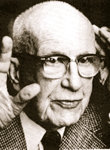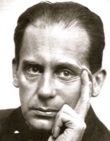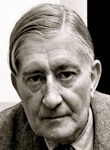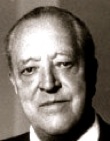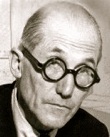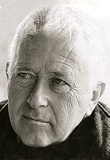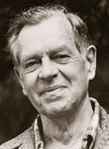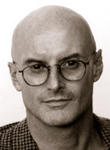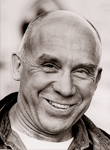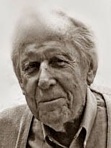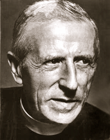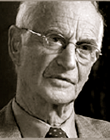Frank Lloyd Wright (1867 - 1959) who forbade faculty to be present during his lectures at Harvard during the time Johansen was a student there, encouraged students to “leave Harvard immediately.” He said, "The architect must be a prophet… a prophet in the true sense of the term. If he can't see at least ten years ahead, don't call him an ‘architect.’“





“Buckminster Fuller (1895 -1983) is a good friend of mine, and he is one of the great geniuses of the United States (one of the few). We never worked together, but we talked together. Or rather, he talked all the time and I didn't talk much at all! It was rather amusing but wonderful! I knew him during the Second World War in Washington while we were there together. I've seen him on and off. He has stunning views on transdisciplinarity. When he asked an architect 'how much does your building weigh?' it was a shocking thing that no one had ever though of saying. After that he said that the average building weighs ten times the amount it carries, which was also shocking. That then paved the way for the whole movement of lighter, quicker, less expensive, more serviceable buildings. And of course, these are the pressures that dominate today due to costs. So he has been a very real influence on me.”
- John M Johansen (in an interview with Hans Ulrich Obrist)
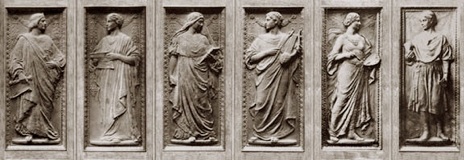
Both of Johansen’s parents were members of the esteemed Academy of Arts and Letters, an honor society of 250 architects, composers, artists and writers. Members, who are chosen on an invitation-only basis, pay no dues and retain their membership for life, include leading figures in the American arts scene. John M Johansen was elected to the Academy of Arts and Letters in 1979. It is interesting to note that John Johansen is the only member whose both parents were also members. The magnificent plate (above) adorns the front of the Academy of Arts and Letters Building.

Greatly admired by Johansen, Mies van der Rohe (1886 - 1969) was a major force in Johansen’s formative years of architecture. Widely acknowledged as one of the pioneers of Modern Architecture, Mies studied philosophy and incorporated a high level of abstraction in his architecture. As Nazi pressures escalated in Germany, Mies - who briefly served as the last Bauhaus Director in 1933 - was forced to close the school; he emigrated to the US in 1937.
Ken Wilber (1949 - ) Johansen enjoys the radical theories, philosophical viewpoints, use of new technologies, and metaphysical ideas of this American author (Sex, Ecology, Spirituality: The Spirit of Evolution).
Stephen Hawking (1942 - ) A theoretical physicist and cosmologist who believes that “space is the Earth's only long term hope.” Hawking’s theory of "top-down cosmology" says that the universe had no unique initial state but is governed by the laws of science. “The laws may have been decreed by God, but God does not intervene to break the laws." He has also published books for the lay person about the universe.
Joseph Campbell (1904 - 1987) American mythologist, writer, and lecturer, Campbell is best known for his work in comparative religion, universal symbols, archetypes, and the relation of myth to the human psyche.
Thomas Berry (1914 – 2009) considered to be a leader in the tradition of Teilhard de Chardin, Berry was an advocate of deep ecology and ecospirituality, and was famous for proposing that an understanding of the history and functioning of the evolving universe is a necessary inspiration and guide for our own effective functioning as individuals and as a species.
K. Eric Drexler (1955 - ) An American engineer, Drexler is best known for popularizing the potential of molecular nanotechnology (MNT). His book “Engines of Creation: The Coming Era of Nanotechnology” provided inspiration for Johansen’s nanoarchitectural designs and ideas.
Walter Gropius (1883 - 1969) was a German architect and founder of the Bauhaus School. Along with Ludwig Mies van der Rohe and Le Corbusier, Gropius is widely regarded as one of the pioneering masters of modern architecture. A student in Gropius’ first class at Harvard, Johansen remembers attending a picnic where he met Gropius’ beautiful young daughter, Ati, who was there with her father. Many years later Johansen married her.
Charles-Édouard Jeanneret-Gris (1887 - 1965), popularly known as Le Corbusier, was a Swiss architect, designer, urbanist, painter, and writer. Famous for being one of the pioneers of Modern Architecture, he was also a close friend of Johansen’s.
Josef Albers (1888 - 1976) was a German-born American artist and educator. His use of patterns and intense colors heavily influenced American artists, including John Johansen, and formed the basis of some of the most far-reaching art education programs of the 20th century. John Johansen’s wife, Ati Gropius, is a former graduate student of Albers who has been teaching his approach to color for many years.
Marcel Breuer (1902 - 1981) was an architect and furniture designer who studied at the Bauhaus and later taught at Harvard’s Architecture school. Born in Hungary, Breuer immigrated to London then the US, during Nazi rise to power. Considered to be one of the masters of Modern Architecture, he is best known for his architecture of the Whitney Museum of Modern Art. A colleague and friend of Walter Gropius, he was good friends with John Johansen.
Thomas Merton (1915 - 1968) Thomas Merton was a writer, poet, social activist and Catholic priest. Widely recognized as one of 20th-century America’s most important mystics and thinkers, he wrote more than 70 books on spirituality, social justice and pacifism.
French philosopher, Jung psychologist, Jesuit priest, paleontologist and geologist Pierre Teilhard de Chardin (1881 - 1955) abandoned traditional teachings in the Book of Genesis, believing in the unfolding of the cosmos - from primordial particles to the development of life, human beings and the noosphere, and finally to his vision of the Omega Point in the future, which is "pulling" all creation towards it. "Someday, after mastering the winds, the waves, the tides and gravity, we shall harness for God the energies of love, and then, for a second time in the history of the world, man will have discovered fire.‘ - Pierre Teilhard de Chardin
James Hillman (1926 - ) American psychologist, Pulitzer Prize Nominee (Re-visioning Psychology) and author of The Soul’s Code: In Search of Character and Calling. Known to be a critic of 20th century psychology, Hillman said modern psychology is “without soul.” “It helps to regard soul as an active intelligence, forming and plotting each person’s fate.”
